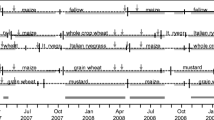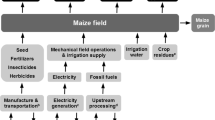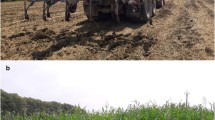Abstract
To mitigate the effects of climate change, the emission of greenhouse gases (GHG) should be reduced. In the near future, an increased use of biomass for energy production will be prescribed by law in the European Union (EU) to achieve the target of emission reduction. One possibility to use biomass energetically is its transformation into biogas. The most widely grown crop for this purpose is maize. Although, the increased use of maize as biogas feedstock, due to generous subsidies, is linked to several ecological and (socio)economic problems. The most important are soil erosion, depletion and compaction, high demand and subsequent leaching of fertilizers/biocides, heavy workload, and competition for land between food and energy production. In contrast, the use of second-generation perennial energy crops (PECs) as biogas feedstock can be an auspicious approach to improve the environmental footprint of biomass production. Therefore, we evaluated and compared the biochemical methane potential (BMP) of five different perennial species (cup plant, virginia mallow, tall wheatgrass, giant knotweed, reed canary grass) and a wild plant mix (composite of 25 in parts perennial plants) on three different sites in West-Germany. In terms of methane production per area, tall wheatgrass and reed canary grass exceeded the productivity of maize under favorable conditions. Hence, we recommend both species as biogas feedstock for Central Europe or comparable climates. Additionally, other species might be suitable for biomethanation from an overall perspective, to enhance (agro)biodiversity in rural areas.



Similar content being viewed by others
Abbreviations
- 2G:
-
Second generation
- %:
-
Percent per weight
- ADF:
-
Acid detergent fiber
- ADL:
-
Acid detergent lignin
- AEC:
-
Annual energy crops
- amsl:
-
Above mean sea level
- BMP:
-
Biochemical methane potential
- c.v.:
-
Cultivated variety
- DLR:
-
Agricultural Service Center, Rhineland-Palatinate (Dienstleistungszentrum ländlicher Raum)
- EU:
-
European Union
- FM:
-
Fresh matter
- GHG:
-
Greenhouse gas
- ha:
-
Hectare = 100 m ∙ 100 m = 10,000 m2
- NDF:
-
Neutral detergent fiber
- PEC:
-
Perennial energy crops
- t:
-
Tons (= 1 Mg = 1000 kg)
- TS:
-
Total solids
- VS:
-
Volatile solids
References
IPCC (2014) Climate Change 2014: Synthesis Report: Contribution of Working Groups I, II and III to the Fifth Assessment Report of the Intergovernmental Panel on Climate Change. Switzerland, Geneva
European Parliament (2009) Directive 2009/28/EC of the European Parliament and of the Council on the promotion of the use of energy from renewable sources and amending and subsequently repealing Directives 2001/77/EC and 2003/30/EC, L140/16, Official J. Eur. Union
Federal Ministry for the Environment, Nature Conservation and Nuclear Safety & Federal Ministry of Food and Agriculture (2009) National biomass action plan: contribution of biomass to sustainable energy supply. https://www.bmbf.de/files/BiomasseaktionsplanNational.pdf. Accessed 24 Sept 2018
Graebig M, Bringezu S, Fenner R (2010) Comparative analysis of environmental impacts of maize–biogas and photovoltaics on a land use basis. Sol Energy 84(7):1255–1263. https://doi.org/10.1016/j.solener.2010.04.002
Herrmann C, Idler C, Heiermann M (2016) Biogas crops grown in energy crop rotations: linking chemical composition and methane production characteristics. Bioresour Technol 206:23–35. https://doi.org/10.1016/j.biortech.2016.01.058
Frigon J-C, Guiot SR (2010) Biomethane production from starch and lignocellulosic crops: a comparative review. Biofuels Bioprod Biorefin 4(4):447–458. https://doi.org/10.1002/bbb.229
Hengeveld EJ, van Gemert WJT, Bekkering J, Broekhuis AA (2014) When does decentralized production of biogas and centralized upgrading and injection into the natural gas grid make sense? Biomass Bioenergy 67:363–371. https://doi.org/10.1016/j.biombioe.2014.05.017
Lehtomäki A, Viinikainen TA, Rintala JA (2008) Screening boreal energy crops and crop residues for methane biofuel production. Biomass Bioenergy 32(6):541–550. https://doi.org/10.1016/j.biombioe.2007.11.013
Mast B, Lemmer A, Oechsner H, Reinhardt-Hanisch A, Claupein W, Graeff-Hönninger S (2014) Methane yield potential of novel perennial biogas crops influenced by harvest date. Ind Crop Prod 58:194–203. https://doi.org/10.1016/j.indcrop.2014.04.017
Herrmann A (2013) Biogas production from maize: current state, challenges and prospects. 2. agronomic and environmental aspects. Bioenerg Res 6(1):372–387. https://doi.org/10.1007/s12155-012-9227-x
Holland RA, Eigenbrod F, Muggeridge A et al (2015) A synthesis of the ecosystem services impact of second generation bioenergy crop production. Renew Sust Energ Rev 46:30–40. https://doi.org/10.1016/j.rser.2015.02.003
Heaton E, Long S, Voigt T et al (2004) Miscanthus for renewable energy generation: European Union Experience and Projections for Illinois. Mitig Adapt Strateg Glob Chang 9:433–451
Lewandowski I, Scurlock JMO, Lindvall E, Christou M (2003) The development and current status of perennial rhizomatous grasses as energy crops in the US and Europe. Biomass Bioenergy 25(4):335–361. https://doi.org/10.1016/S0961-9534(03)00030-8
Bauböck R, Karpenstein-Machan M, Kappas M (2014) Computing the biomass potentials for maize and two alternative energy crops, triticale and cup plant (Silphium perfoliatum L.), with the crop model BioSTAR in the region of Hannover (Germany). Environ Sci Eur 26(1):19. https://doi.org/10.1186/s12302-014-0019-0
Gansberger M, Montgomery LFR, Liebhard P (2015) Botanical characteristics, crop management and potential of Silphium perfoliatum L. as a renewable resource for biogas production: a review. Ind Crop Prod 63:362–372. https://doi.org/10.1016/j.indcrop.2014.09.047
Nabel M, Barbosa DBP, Horsch D, Jablonowski ND (2014) Energy crop (Sida Hermaphrodita) fertilization using digestate under marginal soil conditions: a dose-response experiment. Energy Procedia 59:127–133. https://doi.org/10.1016/j.egypro.2014.10.358
Don A, Osborne B, Hastings A, Skiba U, Carter MS, Drewer J, Flessa H, Freibauer A, Hyvönen N, Jones MB, Lanigan GJ, Mander Ü, Monti A, Djomo SN, Valentine J, Walter K, Zegada-Lizarazu W, Zenone T (2012) Land-use change to bioenergy production in Europe: implications for the greenhouse gas balance and soil carbon. GCB Bioenergy 4(4):372–391. https://doi.org/10.1111/j.1757-1707.2011.01116.x
Adler PR, Del Grosso SJ, Parton WJ (2007) Life-cycle assessment of net greenhouse-gas flux for bioenergy cropping systems. Ecol Appl 17(3):675–691
Emmerling C, Schmidt A, Ruf T, von Francken-Welz H, Thielen S (2017) Impact of newly introduced perennial bioenergy crops on soil quality parameters at three different locations in W-Germany. J Plant Nutr Soil Sci 180(6):759–767. https://doi.org/10.1002/jpln.201700162
Emmerling C (2014) Impact of land-use change towards perennial energy crops on earthworm population. Appl Soil Ecol 84:12–15. https://doi.org/10.1016/j.apsoil.2014.06.006
Schorpp Q, Schrader S (2016) Earthworm functional groups respond to the perennial energy cropping system of the cup plant (Silphium perfoliatum L.). Biomass Bioenergy 87:61–68. https://doi.org/10.1016/j.biombioe.2016.02.009
Semere T, Slater F (2007) Invertebrate populations in miscanthus (Miscanthus × giganteus) and reed canary-grass (Phalaris arundinacea) fields. Biomass Bioenergy 31(1):30–39. https://doi.org/10.1016/j.biombioe.2006.07.002
Kreuger E, Nges IA, Björnsson L (2011) Ensiling of crops for biogas production: effects on methane yield and total solids determination. Biotechnol Biofuels 4:44–51. https://doi.org/10.1186/1754-6834-4-44
Porter MG, Murray RS (2001) The volatility of components of grass silage on oven drying and the inter-relationship between dry-matter content estimated by different analytical methods. Grass Forage Sci 56:405–411
Verein Deutscher Ingenieure (2006) VDI 4630—fermentation of organic materials—characterisation of the substrate, sampling, collection of material data, fermentation tests. Beuth Verlag, Düsseldorf
Raposo F, de La RMA, Fernández-Cegrí V et al (2012) Anaerobic digestion of solid organic substrates in batch mode: an overview relating to methane yields and experimental procedures. Renew Sust Energ Rev 16(1):861–877. https://doi.org/10.1016/j.rser.2011.09.008
Mayer F, Gerin PA, Noo A, Lemaigre S, Stilmant D, Schmit T, Leclech N, Ruelle L, Gennen J, von Francken-Welz H, Foucart G, Flammang J, Weyland M, Delfosse P (2014) Assessment of energy crops alternative to maize for biogas production in the Greater Region. Bioresour Technol 166:358–367. https://doi.org/10.1016/j.biortech.2014.05.054
Groot JCJ, Cone JW, Williams BA, Debersaques FMA, Lantinga EA (1996) Multiphasic analysis of gas production kinetics for in vitro fermentation of ruminant feeds. Anim Feed Sci Technol 64:77–89
Döhler H (2013) Faustzahlen Biogas, vol 3. Ausg. Kuratorium für Technik und Bauwesen in der Landwirtschaft, Darmstadt
Amon T, Amon B, Kryvoruchko V, Zollitsch W, Mayer K, Gruber L (2007) Biogas production from maize and dairy cattle manure—influence of biomass composition on the methane yield. Agric Ecosyst Environ 118(1–4):173–182. https://doi.org/10.1016/j.agee.2006.05.007
Grieder C, Dhillon BS, Schipprack W, Melchinger AE (2012) Breeding maize as biogas substrate in Central Europe: I. Quantitative-genetic parameters for testcross performance. Theor Appl Genet 124(6):971–980. https://doi.org/10.1007/s00122-011-1761-y
Grieder C, Dhillon BS, Schipprack W, Melchinger AE (2012) Breeding maize as biogas substrate in Central Europe: II. Quantitative-genetic parameters for inbred lines and correlations with testcross performance. Theor Appl Genet 124(6):981–988. https://doi.org/10.1007/s00122-011-1762-x
Kaiser F, Gronauer A (2007) Methanproduktivität nachwachsender Rohstoffe in Biogasanlagen. Freising-Weihenstephan. https://www.lfl.bayern.de/mam/cms07/publikationen/daten/informationen/p_27455.pdf. Accessed 24 Sept 2018
Haughton AJ, Bohan DA, Clark SJ, Mallott MD, Mallott V, Sage R, Karp A (2016) Dedicated biomass crops can enhance biodiversity in the arable landscape. GCB Bioenergy 8(6):1071–1081. https://doi.org/10.1111/gcbb.12312
Dickeduisberg M, Laser H, Tonn B, Isselstein J (2017) Tall wheatgrass (Agropyron elongatum) for biogas production: crop management more important for biomass and methane yield than grass provenance. Ind Crop Prod 97:653–663. https://doi.org/10.1016/j.indcrop.2016.12.055
Schoo B, Wittich KP, Böttcher U, Kage H, Schittenhelm S (2016) Drought tolerance and water-use efficiency of biogas crops: a comparison of cup plant, maize and lucerne-grass. J Agron Crop Sci 203(2):117–130. https://doi.org/10.1111/jac.12173
Haag NL, Nägele H-J, Reiss K, Biertümpfel A, Oechsner H (2015) Methane formation potential of cup plant (Silphium perfoliatum). Biomass Bioenergy 75:126–133. https://doi.org/10.1016/j.biombioe.2015.02.012
Oleszek M, Matyka M, Lalak J et al (2013) Characterization of Sida hermaphrodita as a feedstock for anaerobic digestion process. J Food Agric Environ 3 & 4:1839–1841
Nabel M, Temperton VM, Poorter H, Lücke A, Jablonowski ND (2016) Energizing marginal soils—the establishment of the energy crop Sida hermaphrodita as dependent on digestate fertilization, NPK, and legume intercropping. Biomass Bioenergy 87:9–16. https://doi.org/10.1016/j.biombioe.2016.02.010
Jablonowski ND, Kollmann T, Nabel M, Damm T, Klose H, Müller M, Bläsing M, Seebold S, Krafft S, Kuperjans I, Dahmen M, Schurr U (2017) Valorization of Sida (Sida hermaphrodita ) biomass for multiple energy purposes. GCB Bioenergy 9(1):202–214. https://doi.org/10.1111/gcbb.12346
Borkowska H, Molas R (2012) Two extremely different crops, Salix and Sida, as sources of renewable bioenergy. Biomass Bioenergy 36:234–240. https://doi.org/10.1016/j.biombioe.2011.10.025
Barbosa DBP, Nabel M, Jablonowski ND (2014) Biogas-digestate as nutrient source for biomass production of Sida Hermaphrodita, Zea Mays L. and Medicago sativa L. Energy Procedia 59:120–126. https://doi.org/10.1016/j.egypro.2014.10.357
Sanderson MA, Adler PR (2008) Perennial forages as second generation bioenergy crops. Int J Mol Sci 9(5):768–788. https://doi.org/10.3390/ijms9050768
Mantovani D, Veste M, Gypser S, Halke C, Koning L, Freese D, Lebzien S (2014) Transpiration and biomass production of the bioenergy crop Giant Knotweed Igniscum under various supplies of water and nutrients. J Hydrol Hydromech 62(4):316–323. https://doi.org/10.2478/johh-2014-0028
von Cossel M, Lewandowski I (2016) Perennial wild plant mixtures for biomass production: Impact of species composition dynamics on yield performance over a five-year cultivation period in southwest Germany. Eur J Agron 79:74–89. https://doi.org/10.1016/j.eja.2016.05.006
Matthews J, Beringen R, Huijbregts MAJ et al (2015) Horizon scanning and environmental risk analyses of non-native biomass crops in Netherlands, Nijmegen. https://www.nvwa.nl/documenten/plant/planten-in-de-natuur/exoten/risicobeoordelingen/horizon-scanning-and-environmental-risk-analyses-of-non-native-biomass-crops-in-the-netherlands. Accessed 24 Sept 2018
Dienstleistungszentren Ländlicher Raum (2018) Temperature and precipitation data 2014 and long term average (1951-1980). Stations Wittlich (near site Altrich), Simmern-Wahlbach (near site Klosterkumbd), Speyer (at site Speyer). http://wetter.rlp.de/Internet/global/inetcntr.nsf/dlr_web_full.xsp?src=L941ES4AB8&p1=1PJCNH7DKW&p3=9IQ84WEY3L&p4=XJPZBV4849. Accessed 21 Feb 2018
Liebetrau J, Clemens J, Cuhls C, Hafermann C, Friehe J, Weiland P, Daniel-Gromke J (2010) Methane emissions from biogas-producing facilities within the agricultural sector. Eng Life Sci 10(6):595–599. https://doi.org/10.1002/elsc.201000070
Šiaudinis G, Jasinskas A, Slepetiene A et al (2012) The evaluation of biomass and energy productivity of common mugwort (Artemisia vulgaris L.) and cup plant (Silphium perfoliatum L.) in Albeluvisol. Agriculture 99:357–362
Šiaudinis G, Šlepetienė A, Karčauskienė D (2012) The Evaluation of dry mass yield of new energy crops and their energetic parameters, In: Renewable Energy and Energy Efficiency: Proceedings of the International Scientific Conference. Jelgava, Latvia
Herrmann C, Plogsties V, Willms M et al (2016) Methane production potential of various crop species grown in energy crop rotations. LANDTECHNIK – Agricultural Engineering 71(6):194–208. https://doi.org/10.15150/lt.2016.3142
Weiland P (2010) Biogas production: current state and perspectives. Appl Microbiol Biotechnol 85(4):849–860. https://doi.org/10.1007/s00253-009-2246-7
Piatek M, Lisowski A, Kasprzycka A et al (2016) The dynamics of an anaerobic digestion of crop substrates with an unfavourable carbon to nitrogen ratio. Bioresour Technol 216:607–612. https://doi.org/10.1016/j.biortech.2016.05.122
Skorupskaite V, Makareviciene V, Šiaudinis G et al (2015) Green energy from different feedstock processed under anaerobic conditions. Agron Res 13(2):420–429
Franzaring J, Schmidt I, Bäuerle G et al (2014) Investigations on plant functional traits, epidermal structures and the ecophysiology of the novel bioenergy species Sida hermaphrodita Rusby and Silphium perfoliatum L. J Appl Bot Food Qual 87:36–45. https://doi.org/10.5073/JABFQ.2014.087.006
Šiaudinis G, Jasinskas A, Šarauskis E, Steponavičius D, Karčauskienė D, Liaudanskienė I (2015) The assessment of Virginia mallow (Sida hermaphrodita Rusby) and cup plant (Silphium perfoliatum L.) productivity, physico–mechanical properties and energy expenses. Energy 93:606–612. https://doi.org/10.1016/j.energy.2015.09.065
Franzaring J, Holz I, Kauf Z, Fangmeier A (2015) Responses of the novel bioenergy plant species Sida hermaphrodita (L.) Rusby and Silphium perfoliatum L. to CO2 fertilization at different temperatures and water supply. Biomass Bioenergy 81:574–583. https://doi.org/10.1016/j.biombioe.2015.07.031
Shinners KJ, Boettcher GC, Muck RE et al (2010) Harvest and storage of two perennial grasses as biomass feedstocks. Trans ASABE 53(2):359–370
Kacprzak A, Matyka M, Krzystek L, Ledakowicz S (2012) Evaluation of biogas collection from reed canary grass, depending on nitrogen fertilization levels. Chem Process Eng 33(4):697–701. https://doi.org/10.2478/v10176-012-0059-1
Partala A, Mela T, Esala M, Ketoja E (2001) Plant Recovery of 15N-labelled nitrogen applied to reeed canary grass grown for biomass. Nutr Cycl Agroecosyst 61:273–281
Triolo JM, Pedersen L, Qu H, Sommer SG (2012) Biochemical methane potential and anaerobic biodegradability of non-herbaceous and herbaceous phytomass in biogas production. Bioresour Technol 125:226–232. https://doi.org/10.1016/j.biortech.2012.08.079
Oleszek M, Krol A, Tys J et al (2014) Comparison of biogas production from wild and cultivated varieties of reed canary grass. Bioresour Technol 156:303–306. https://doi.org/10.1016/j.biortech.2014.01.055
Nayeripour M (2011) Sustainable growth and applications in renewable energy sources. InTech, London
Lalak J, Kasprzycka A, Martyniak D, Tys J (2016) Effect of biological pretreatment of Agropyron elongatum ‘BAMAR’ on biogas production by anaerobic digestion. Bioresour Technol 200:194–200. https://doi.org/10.1016/j.biortech.2015.10.022
Meerbeek K, Appels L, Dewil R et al (2015) Biomass of invasive plant species as a potential feedstock for bioenergy production. Biofuels Bioprod Biorefin 9(3):273–282. https://doi.org/10.1002/bbb.1539
Acknowledgements
The authors would like to thank Sebastian Thielen, Otto Lang, and Dr. Martin Armbruster for the opportunity to take samples from the field trials of the DLR. We would also like to express gratitude to Anaïs Noo and Bénédicte De Vos for their valuable support conducting the BMP measurements.
Funding
This work has been financially supported by the Ministry of Education, Science, Youth & Culture Rhineland-Palatinate, Germany, within the Research Initiative: Trier Centre of Sustainable Studies (TriCSS), 04/2013 – 12/2016, University of Trier.
Author information
Authors and Affiliations
Corresponding author
Additional information
Publisher’s Note
Springer Nature remains neutral with regard to jurisdictional claims in published maps and institutional affiliations.
Rights and permissions
About this article
Cite this article
Schmidt, A., Lemaigre, S., Delfosse, P. et al. Biochemical methane potential (BMP) of six perennial energy crops cultivated at three different locations in W-Germany. Biomass Conv. Bioref. 8, 873–888 (2018). https://doi.org/10.1007/s13399-018-0338-2
Received:
Revised:
Accepted:
Published:
Issue Date:
DOI: https://doi.org/10.1007/s13399-018-0338-2




